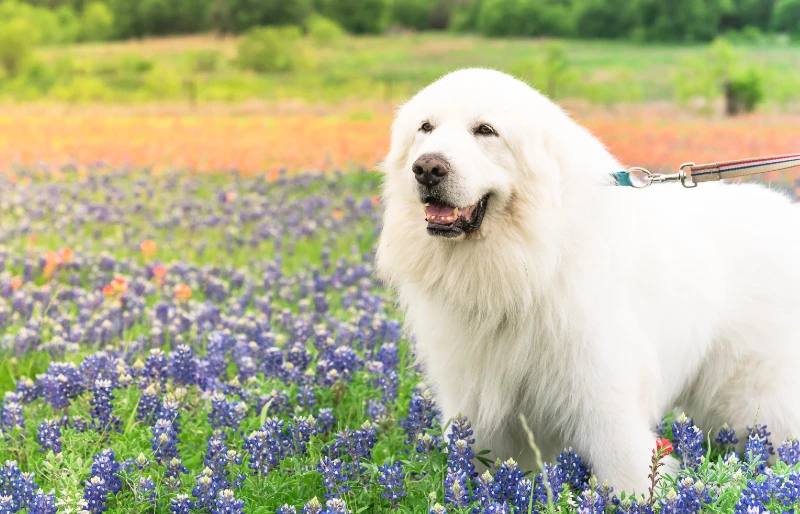Black Great Pyrenees: Facts, Origin & History (With Pictures)
Updated on

Click to Skip Ahead
The Great Pyrenees is a giant dog breed that is known for its distinctive white coat, which is thick, long, and fluffy. You probably weren’t aware, though, that the Great Pyrenees can appear in other coat colors as well, including black. Not to be confused with the all-black Newfoundland, the black Great Pyrenees is surrounded by some controversy.
Breed Overview
| Height: | 25–32 inches |
| Weight: | 85+ pounds |
| Lifespan: | 10–12 years |
| Colors: | Black, black and white |
| Suitable for: | Livestock guardian work, experienced dog owners, homes with lots of land |
| Temperament: | Laidback, smart, stubborn |
The controversy surrounding the black Great Pyrenees is that many people believe that to achieve this color in the breed, the dog must be bred out to another breed, making them not purebred. There are people who claim that their black Great Pyrenees dogs are purebred, though. After all, how can you get a black coat out of a breed whose only standard color is white? Either way, more often than not, if you’re seeing a black Great Pyrenees, you’re likely seeing a mixed-breed dog.
Black Great Pyrenees Characteristics
The Earliest Records of Black Great Pyrenees in History
It’s unclear when black Great Pyrenees first started showing up because there have been so many dogs that were Great Pyrenees mixes throughout the years. The Great Pyrenees breed is old, though, having started to make appearances across Europe in the 1600s, but some fossils have indicated that the breed was in the Pyrenean Mountains between 1800 and 1000 BCE. It’s estimated that the breed is older than this, though, likely coming to be sometime around 3000 BCE.
Although named for the Pyrenean Mountain range that separates Spain and France, the breed was likely in existence and brought to the Pyrenean Mountains when the first shepherds and farmers settled in the area.

How Black Great Pyrenees Gained Popularity
Because of their tendency to wander, it’s not uncommon to find Great Pyrenees mixes, especially in rural areas with lots of farmland. While the Great Pyrenees is often not considered a great house dog, it may breed with more outgoing, family-friendly dogs, like the Labrador and Golden Retrievers. Breeding with breeds that contain genes for a black coat, like the Labrador, can result in dogs that look very much like a Great Pyrenees but with a fully or mostly black coat.
Formal Recognition of the Black Great Pyrenees
Black is not considered an accepted coat color in the breed standard of the Great Pyrenees, so these dogs are not accepted by any kennel clubs currently. In order to get black added as part of the breed standard, thorough records showing a purebred lineage and proof that these dogs are not mixed breeds will likely be required.

Concerns with the Black Great Pyrenees
Since it’s likely that most black Great Pyrenees are mixed breeds, it’s important to take all aspects of the dog’s potential health into consideration. Backyard and accidental breeding, whether these dogs are purebred or not, allows for poor genetics to be perpetuated. These poor genetics often carry health problems with them.
Anyone selling a dog to you as a black Great Pyrenees is either not telling the truth about the parentage of the dog or they are breeding dogs that don’t follow the standard of the breed, neither of which are great options. If you decide to purchase a pup from someone who bred the dog, it’s important to verify that the parents received all health testing recommended for the Great Pyrenees breed prior to being bred.
Top 3 Unique Facts About Black Great Pyrenees
1. They’re Gentle
The Great Pyrenees breed is a livestock guardian breed, so it is instilled in them that they are to protect livestock and other animals and people around them. Because of this, the breed is known for being very gentle, even with small animals.
2. They’re Strong
Great Pyrenees can get very large, with some exceeding 150 pounds. They are not only large but also very strong dogs. In fact, during World War II, Great Pyrenees were used to haul artillery across the Pyrenean Mountains between France and Spain.
3. They’re Stubborn
This breed isn’t for everyone, especially if you’re looking for a dog that listens to you all the time. They’re known for being exceptionally stubborn but also intelligent. This means that your dog likely understands the commands that you’re giving it, but they’re known for blatantly ignoring commands. They also may lie down on a walk or during an activity they don’t want to do, refusing to go any further.

Does the Black Great Pyrenees Make a Good Pet?
The Great Pyrenees is a lovely dog, but it’s not for everyone. Because of their instinct to protect and walk long distances, they have a tendency to wander from home and may not be appeased by the average backyard. They can also be aloof with strangers, and because of their protective nature, they make great guard dogs that may not like visitors coming to your home. Their size makes bad behavior a major risk, so proper socialization and early training are necessary aspects of owning this breed.
Conclusion
The black Great Pyrenees is a beautiful dog, but many people don’t consider it to be a purebred Great Pyrenees. The coat color doesn’t fall within the breed standard, so black Great Pyrenees are not accepted by any major kennel club currently.
This breed can be difficult to keep in the average household, and they require an experienced owner who will provide them with training and socialization from a young age. Be wary of someone trying to sell you a black Great Pyrenees as a purebred dog, though, since there are concerns about the ethics of their breeding practices.
Featured Image Credit: O. Rae, Shutterstock













